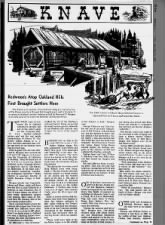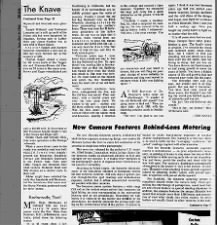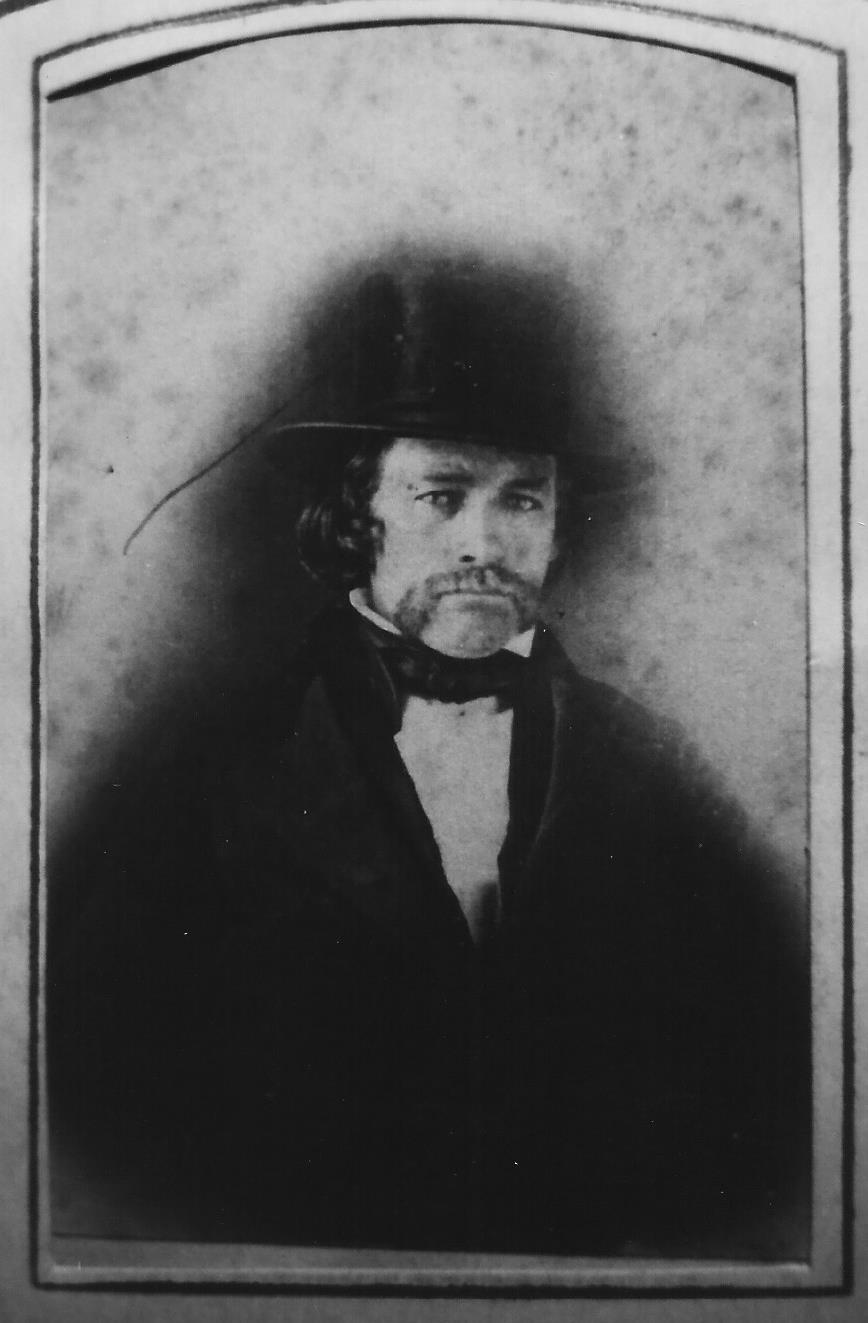Redwoods Atop Oakland Hills First Brought Settlers Here - Oakland Tribune - 09 Oct 1966, Sun - Page 137
Redwoods Atop Oakland Hills First Brought Settlers Here
 THE KNAVE
History of Redwood harvesting in Oakland, part 1 Sun, Oct 9, 1966 – 137 · Oakland Tribune (Oakland, California) · Newspapers.com
THE KNAVE
History of Redwood harvesting in Oakland, part 1 Sun, Oct 9, 1966 – 137 · Oakland Tribune (Oakland, California) · Newspapers.com THE KNAVE
History of Redwood harvesting in Oakland, part 2 Sun, Oct 9, 1966 – 140 · Oakland Tribune (Oakland, California) · Newspapers.com
THE KNAVE
History of Redwood harvesting in Oakland, part 2 Sun, Oct 9, 1966 – 140 · Oakland Tribune (Oakland, California) · Newspapers.com
 |
| The 1849 lumber mill built above Dimond Canyon is depicted here by Tribune staff artist Ray Marta |
(The Knave is on vacation. Presented here today is a reprint of one of The Knave reports of the past that brought much mail to his desk. It is a story of Oakland's earliest industry as told by Sherwood D. Burgess in an early issue of the California Historical Society Quarterly.)
THE FIRST signs of economic life in Oakland centered in the hills and not at the water's edge
on San Francisco Bay. It was lumber - redwood lumber - and not the real estate manipulations of Horace W. Carpentier, [in Oakland Localwiki - MF] Edson Adams or A. J. Moon that first attracted men to labor and dwell in the Eastbay more than 112 years ago.
First to point this out was Sherwood D. Burgess [at archive.org - MF] who received his A.B. and A.M. degrees (in history) from the University of California at Berkeley. Next he found two of his history-making theses published in the California Historical Quarterly, one on "The Forgotten Redwoods of the East Bay," and another concerning "Lumbering in Hispanic California." Today Burgess is assistant director of Healds Business College in Oakland. [Read the two theses linked here, this article is a light summary. - MF]
Burgess admits that Carpentier, Adams and Moon might well have been the first to plan Oakland as a bedroom to San Francisco, but at least 10 years before the advent of these realty speculators, loggers were hauling their loads of redwood from the Eastbay hills to the San Antonio embarcadero.
These redwood timbers from the Oakland hills helped San Francisco rebuild five different times after disastrous fires in 1851 alone. There's no doubt about it, Oakland was once a bustling lumber town. Perhaps the first sawmilling town of importance in California.
By 1860 only a “sea of stumps" marked the site of the Eastbay's redwood forests. Today we see but the small second-growth redwoods in the Oakland hills and can only imagine the extent of the original forest.
BURGESS tells us that in the early 1840's the names of John Sutter, Nathan Spear, William Leidesdorff, Elam Brown and Harry Meiggs were associated with lumbering in this area. [Click those links and read about those people. -MF] “Before 1849," he reports, "the entire forest was known as the San Antonio redwoods, its name being derived from the Peralta's Rancho San Antonio.
"But during the American period three distinct areas were recognized. 1. The San Antonio redwoods became limited to a forest section on the skyline and the western slopes of the hills. 2. The area in the canyon formed by Redwood Creek (now Redwood Regional Park) was known as the middle Redwoods. 3. Farther east, in the canyon of upper San Leandro Creek, were the Moraga redwoods."
There is some evidence that foreigners may have been logging in these San Antonio redwoods in 1834. Again studying the Burgess papers we learn that the commandante of the San Francisco presidio complained to the Monterey assembly that foreigners were destroying forests within his jurisdiction.
"These could have been in the San Mateo region or in the vicinity of San Antonio, or both,” Burgess says.
George Patterson and John Parker are two of the early whipsawyers to fell Eastbay redwood trees and sell the timbers to Sutter who had settled in the Sacramento Valley. Harry J. Bee also came to this side of the bay from the Santa Cruz redwoods. Two Frenchmen, Sicard and Leroy, found Yerba Buena without lumber for building purposes in the summer of 1841 and exploited the Eastbay redwoods.
Nathan Spear and Capt. William S. Hinckley were here with a sawmill that turned out shingles and planks.
Not until 1846 was there a breaking point. That was the year that American immigrants arrived and displaced the adventurers who had jumped-ship in the harbors of San Francisco and Monterey.
ONE of the first Americans to arrive in the San Antonio forest was Napoleon Bonapart Smith accompanied by his brother, Henry Clay Smith (recognized as the father of Alameda County) and a friend, William Mendenhall. They had come down to Yerba Buena from Sutter's Fort, but wasted little time before proceeding to the redwoods.
"During the summer and fall of 1847," Burgess says, "the Smith brothers along with Elam Brown and Bill Mendenhall whipsawed lumber and hauled it to the San Antonio embarcadero, what we know today as the foot of 14th Avenue. It was during this period that Elam Brown met William A. Leidesdorff who sold him his Rancho Acalanes (Lafayette).”
Nathan Spear and Capt. William S. Hinckley were here with a sawmill that turned out shingles and planks.
Not until 1846 was there a breaking point. That was the year that American immigrants arrived and displaced the adventurers who had jumped-ship in the harbors of San Francisco and Monterey.
ONE of the first Americans to arrive in the San Antonio forest was Napoleon Bonapart Smith accompanied by his brother, Henry Clay Smith (recognized as the father of Alameda County) and a friend, William Mendenhall. They had come down to Yerba Buena from Sutter's Fort, but wasted little time before proceeding to the redwoods.
 |
| Napoleon Bonaparte Smith |
"During the summer and fall of 1847," Burgess says, "the Smith brothers along with Elam Brown and Bill Mendenhall whipsawed lumber and hauled it to the San Antonio embarcadero, what we know today as the foot of 14th Avenue. It was during this period that Elam Brown met William A. Leidesdorff who sold him his Rancho Acalanes (Lafayette).”
 |
| "...San Antonio embarcadero, what we know today as the foot of 14th Avenue" |
The Harlan family also came to the redwoods in 1847, bringing with them a helper named Richard Swift. And early in 1849 Harry Meiggs sent loggers over to the San Antonio trees.
During 1848 considerable timber from the San Antonio forest went to Dr. Robert Semple who shipped across Suisun Bay to his newly founded Benicia. Lumber from the Moraga redwoods went to the building of Martinez.
"Total population of the Eastbay woods in late 1849 must have been in excess of 100 residents,” Burgess reports.
Then came the steam sawmills. The first steam mill went up in 1850, although an unknown Frenchman had begun construction of a steam mill on Palo Seco Creek a short distance above Dimond Canyon in late 1849.
“Before its completion," Burgess says, "the mill passed into the hands of Harry Meiggs who later sold it to Volney Moody.
OTHER mills and lumbermen followed. However, most of the mills were in the middle redwoods.
Thomas and William Prince established a mill there in 1852. By the middle of that year Oakland, Clinton, San Antonio, Alameda, Hayward and Alvarado were growing.
Joseph Witherall and Nathaniel Lampson put a mill up north of the Prince site but were hampered by litigation, forcing sale to Luther Mills and James Vantine who in turn sold to Henry Spicer.
Chester Tupper and Richard Hamilton established a mill late in 1852 but were burned out in the summer of 1854.
Thomas Eager staked a claim for 160 acres north of the Tupper site and Erasmus Brown did likewise on 55 acres in the same area. Brown and Eager' consolidated and built a $10,000 mill. In November of 1857 Plummer bought Eager's half of the Brown and Eager mill.
Hiram Thorn and William Hamilton were operators in the Moraga redwoods.
When a more direct route to the woods was needed a road was built which followed (very roughly) present day Broadway, Broadway Terrace and Mountain Boulevard to the Prince road. Next year (1853) Tupper and Hamilton built what became Redwood Road and 35th Avenue as a shorter route to their mill.
 |
| 1850s logging roads, courtesy Alan Imler and Amelia Sue Marshall |
Adobe might have satisfied the early day Spaniards and Mexicans, but the Americans that came over the Sierra Nevadas preferred wood for their homes.
Redwoods, Too!
MRS. Hugo Methmann of Oakland tells me that nearly 24 years have passed since the Rev. Mina Ross Brawner, M.D., of Melbourne, Australia, jotted down the following memo:
"It is 45 years since I left Healdsburg in California, but the beauty of its surroundings are indelibly printed upon the walls of memory. Vividly I recall the old but big Redwood tree on Fitch Mountain, standing outside the fence surrounding my mother's home. There was room for 20 frolicsome picnickers in the hollow trunk. Its-top was so high that it seemed, when viewed from our homesite, to pass the distant mountain and blend with the sky. I can only describe it as a 'tree that looks to God all day and lifts its leafy arms to pray.'
"Forty-six years ago I came home from school one day to find the big Redwood on fire. Its open throat was roaring like a furnace. Mother told us that the lightning had ripped down from the clouds and struck it. The roar was terrible. We could stand on the hillside and watch the fire relentlessly burn the heart out of our old landmark.
"But another rainstorm came down, extinguished the fire, and the old tree was saved. Then suddenly, with a fearful crash and roar, the tree came down. We rushed to the spot – mother and the three children who were home. Was the tree gone? The nook seemed filled with the fallen trunk and branches. Quickly I returned to the cottage and secured a tape-measure. Together we measured the huge pole lying like a giant submarine on the ground. It was 90 feet long.
"Carefully I made a notation. But, oh, what a surprise! On looking up, the tree seemed to be as tall as before. Softly I whispered: "Old tree, I like your courage. You are storm-torn and your heart is broken, but you will fling out your poor stumps of arms defiantly to the storms and sing your loudest in the hard winds. I like your fighting spirit.'"
AT THE bottom of Dr. Brawner's notes came an afterthought. "I wonder if the old Redwood still stands? I'm going home to find out." Then another date: April, 1943, with the following notation made in Healdsburg
.
"Old tree! I'm glad to see you again. I think it was four thousand years ago that you pushed your tender branches through darkness and the cold slime of the deluge, and began your fight for existence on Fitch Mountain. Here I met you half a century ago. Here you taught my young heart to fight on, no matter what the odds.
"It is 45 years since last we met. Many changes have taken place. Mother is gone. The family circle is smaller. I've crossed the ocean and continent many times since then, but I return to find you standing, tall and stately as a sentinel over my old home, now tottering in decay, but you live on. You have thrown out fresh branches and young growth to cover the scars of battle. You have a hidden source of life and growth that has renewed your youth like the eagle.
"Old Stovepipe they call you now, and wonder how it all happened. But you and I remember. You have kept your secret all these years, but tonight I am telling the world you battled against all obstacles and won out.
"Oh, joy! The old Redwood still stands."
"This is fact, not fiction,” Mrs. Methmann adds.
-THE KNAVE

Comments
Post a Comment